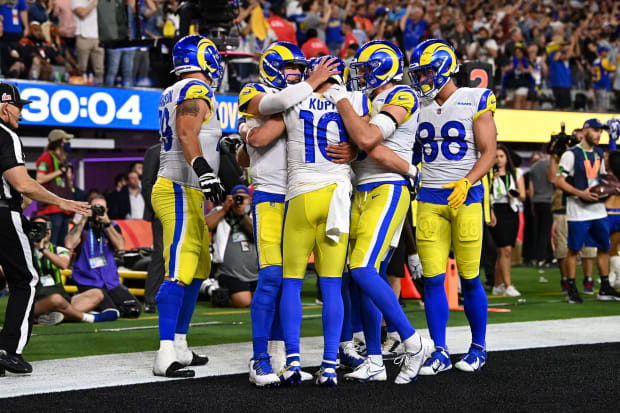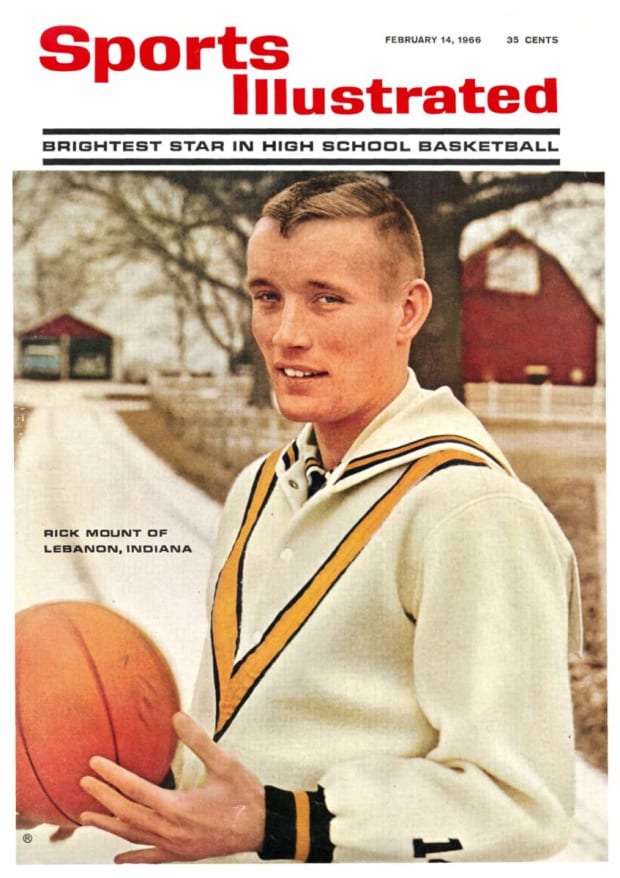These plays are the ones we’ll remember when looking back on this game.
Good morning. I’m Dan Gartland, trying my best to make sense of an eventful Super Bowl.
If you're reading this on SI.com, you can sign up to get this free newsletter in your inbox each weekday at SI.com/newsletters.
Not a thriller, but a pretty good game
The Rams’ big gamble, mortgaging their future by trading boatloads of draft picks to acquire established stars, paid off. They’re now Super Bowl champions for the first time in more than 20 years.
The game didn’t match the intensity of what had been the most thrilling postseason in NFL history (the seven consecutive punts in the second half had me looking at my phone more than at the TV), but at least it was better than last year’s 31–9 blowout.
Here are the six plays that stuck out to me as the ones I’ll remember most:
6. Joe Mixon’s touchdown pass to Tee Higgins:
This trick play didn’t have an enormous impact on the game (it made it 13–10 late in the second quarter), but it sure was fun. And I think that’s what will stick in fans’ minds as they look back on this Bengals team. They were fun. They took chances. They made plays however they needed to be made.
5. Higgins’s 75-yard touchdown catch on the first offensive play of the second half (and the egregious missed call)
Speaking of making plays by any means necessary, check out how Joe Burrow escapes the rush on this throw. His offensive line hung him out to dry, but he managed to create enough space for himself to uncork the throw to Higgins before getting hit by a defender.
A long touchdown to start the half was just what the Bengals needed to turn the game in their favor, but they had some help. It wasn’t immediately clear from the broadcast, but Higgins got away with yanking Jalen Ramsey’s facemask. It was a terrible blown call we’d be talking about all week if Cincinnati had hung on to win.
4. Odell Beckham Jr.’s injury
When Beckham forced his way out of Cleveland, it was with the goal of playing in this game. And he made an immediate impact, scoring the Rams’ first touchdown of the game. Before the end of the first half, though, he went down with a non-contact knee injury and did not return. The Rams, already missing reliable tight end Tyler Higbee, were forced to grapple with the loss of another top target.
It isn’t hard to draw a straight line between Beckham’s injury and the Rams’ offensive struggles that followed. Here’s how every Los Angeles drive ended after Beckham went down: interception, punt, interception, field goal, punt, punt, punt, touchdown, victory formation.
3. Cooper Kupp’s 7-yard run on fourth down
Even with Beckham sidelined, the Rams did manage to string together an impressive game-winning drive. They took 15 plays and 4:48 of game time to go 79 yards for the go-ahead score. But the drive almost ended early on. Facing a fourth-and-1 from their own 30, Sean McVay opted to go for it, running a jet sweep with Kupp. He picked up seven yards and kept the drive alive.
Even just a few years ago, most coaches facing fourth-and-short from deep in their own territory with five minutes on the clock and all three timeouts remaining probably would have punted the ball—even in the Super Bowl! McVay’s decision to go for it shows how conventional wisdom has changed in a short period of time. And the fact that the Rams were able to chew time off the clock on their way to taking the lead shows why it was the right call to make.
2. The two bad calls on third-and-goal
The end of that drive was not without controversy, though. On a key third-and-goal play from the 8-yard line with 1:47 on the clock, Cincinnati linebacker Logan Wilson was called for a really weak defensive holding penalty. Even worse, the officials missed a clear false start on the Rams’ entire offensive line.
Instead of facing either a third-and-goal from the 13 (if the false start had been called) or a fourth-and-goal from the 8 (if the hold hadn’t been called), Los Angeles was gifted with a fresh set of downs and the ball at the 1-yard-line, setting up Kupp’s go-ahead touchdown catch.
1. Aaron Donald’s game-sealing pressure
Is it simplistic to put the play that effectively ended the game on this list? Sure. But Donald blowing up the Bengals’ fourth-down play in the final minute was just the last example of the Rams’ defensive front making life hell for Burrow. He was sacked seven times and hit 11. Donald officially had only two sacks (Burrow was able to get a desperate pass away on that last play) but was blowing plays up all game. He had a legitimate MVP case.
The best of Sports Illustrated

John W. McDonough/Sports Illustrated
Albert Breer’s MMQB is all about—you guessed it—the Super Bowl. He even managed to get some one-on-one time with McVay. … Mitch Goldich focused on what this Super Bowl win means for Stafford. … Our Super Bowl commemorative issue is already for sale. … Stephanie Apstein has the story of Erin Jackson, the American who became the first Black woman to win an Olympic speed skating medal.
Around the sports world
Rodney Harrison says Donald told him before the game he may retire if the Rams won. … Eric Weddle tore his pectoral muscle in the first half and played the rest of the game. … Russia Olympic Committee figure skater Kamila Valieva was cleared to compete in Beijing despite a failed drug test. … A French snowboarder unable to complete any tricks due to injury did her run at the Olympics in a tiger costume.
The top 5…
… outside-the-lines Super Bowl moments:
5. Donald’s postgame interview
4. Bengals kicker Evan McPherson chilling on the sidelines watching the halftime show
3. Beckham’s emotional reaction to winning the game
2. Rams safety Taylor Rapp proposing to his girlfriend on the field after the game
1. Rams receiver Van Jefferson rushing to the hospital to see his wife give birth after the game
SIQ
The Rams have now won two championships: Super Bowl XXXIV in 2000 when they were still in St. Louis and last night’s at home in Los Angeles. What are the only two other NFL franchises to win Super Bowls while representing multiple cities?
Check Tuesday's newsletter for the answer.
A quick correction about Friday’s SIQ: I asked which college is the only one to produce a U.S. president and two Super Bowl MVPs. As a few readers pointed out, there are actually two such schools.
Answer: Michigan (Gerald Ford, Tom Brady and Desmond Howard) and Stanford (Herbert Hoover, John Elway and Jim Plunkett). The other schools with presidents and Super Bowl MVPs are the United States Naval Academy (Jimmy Carter and Roger Staubach), Delaware (Joe Biden and Joe Flacco) and Miami of Ohio (Benjamin Harrison and Ben Roethlisberger).
From the Vault: Feb. 14, 1966

On Feb. 14, 1966, Rick Mount became the first high school athlete to be featured on the cover of Sports Illustrated, almost 36 years to the day before a certain other midwestern high school phenom earned the honor. Mount was from Lebanon, Ind., and what you would call today an “automatic bucket.” He scored 2,595 points in his high school career, the second most in Indiana history at the time and still the state’s seventh-best mark. He averaged just over 33 points per game during his junior and senior seasons, making him one of the hottest recruits in the nation.
Mount’s high school principal estimated that 250 colleges had reached out trying to recruit Mount, according to the cover story by Frank Deford. He strongly considered Miami and Indiana but ended up going to Purdue, where he was a three-time All-American. He was drafted by the ABA’s Indiana Pacers after college (strangely, there is some confusion over where he was drafted) and played five decent seasons in that league before a shoulder injury ended his career.
In 2001, Tim Layden caught up with Mount for a story in SI’s “Where Are They Now” issue. It describes how Mount went from local hero to outcast. He got in a fight with a former teammate after learning that the man had called him a “loser” behind his back. Mount became reclusive after being denied a coaching job at a nearby high school because he had not completed his college degree. He also had a bone to pick with Purdue, after coach Gene Keady awarded his No. 10 jersey to another player for the first time in 1988 and relegated his son, Richie, to benchwarmer status. Helping to coach Lebanon’s girl’s team brought him out of his shell, though, and helped mend relationships in town.
Check out more of SI's archives and historic images at vault.si.com.